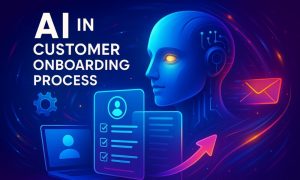The customer success process is all about building an effective business strategy where you are helping your customers fully utilize your company’s product to ensure they get their desired outcomes. Brands apply these steps to increase their customers’ satisfaction level and keep them loyal for a longer period.
Let’s say about the “EcoSense,” which provides a smart home energy management system. The company has made a successful customer success plan with some smart aspects. This may include onboarding, where CSM helps the customer define their energy-saving goals, set up their smart devices, monitor usage patterns, or provide personalized recommendations.
Continue reading to know the details about the customer success process and how it benefits the overall business plans.

What Is The Customer Success Process?
The customer success process is the complete series of steps where the company engages with customers, tracks users’ behavior, and takes proactive actions based on data to ensure desired outcomes from the service of products.
It is far different from customer support, which is reactive, but customer success is proactive. For instance, businesses try to build personal relationships with each customer, monitor customer usage, and identify potential issues before making any decisions.
The goal of this business strategy is to achieve high customer satisfaction, increase the retention rate, reduce the churn rate, and ensure the desired ROI from the investment. Plus, the new customer can also get a quick understanding and a smooth onboarding experience.

Why Is The Customer Success Process Important?
A customer success process is important to maximize customer lifetime value, improve customer satisfaction, and drive revenue growth.
That’s not even the end! Have a look and find how the helped customer success plans can make an unexpected difference in your business.
- Reduced Churn: With the proper customer success strategy, you can engage with customers early and understand their frustration and dissatisfaction areas. You can take the needed steps and stop them from leaving.
- Improved Brand Reputation: Satisfied customers are like powerful advocates. With positive word-of-mouth and referrals from existing customers, there is a chance you can increase your customer base.
- Ongoing Growth: With an effective process, you can manage a growing customer base with efficiency without sacrificing the quality of your service. This helps you generate a steady flow of reviews.
- Reduced Support Costs: Through proactive customer success, you can easily shift from a reactive to a proactive support model. This results in reduced workloads and, the best part, lowering your operational costs at the same time.

How to Build a Customer Success Process: Step-By-Step Guide
1. Identify the Customers Goals and Desire
To truly build a well-provided customer success process, you should have a clear understanding of your customer goals and desires. Find out why customers are buying your products and if there is any lacking that you need to fill.
Through this quick strategy, you can find the ideal customers for your service and adjust your marketing strategy accordingly. Start by focusing on any specialized customer groups and, if needed, ask direct questions about their desired outcomes and related pain points.
2. Define the Red Flags
Not just goal setting will be enough until you identify upcoming potential risks early and help you to implement effective risk mitigation measures. Some of the red flags examples include:
- Decreased product usage.
- Customer inactivity
- Increased support ticket volume.
- Negative feedback or reviews.
- Delayed or missed payments.
- Lack of engagement with onboarding materials.
With the right identification of the patterns and indicators related to the high-risk behavior of the customer, the company can take appropriate action to prevent further harm and reduce the churn rate.
3. Develop a Customer Sucess Team
Next, this is the time to develop effective customer success when you have complete insights into your customer and service. Investing in a well-working customer success team will help you get the customers to rust and let them believe that your company is always dedicated to their inquiries and issues.
With the developed trust, you can increase their satisfaction level as well as their purchasing rates. However, here are a few important roles that your customer success team will ensure:
i) A robust onboarding process: This refers to the first steps of your customer lifecycle, where your success team will set the stages for the entire customer journey. Customers with a positive onboarding process are more likely to be 69% more interested in remaining loyal to the company.
ii) Renewals: Your customer success team will be completely responsible for the renewal strategy or getting the contract signed for your services. It also provides the opportunity for cross-sells and upsells.
iii) Customer Account Overview: Your team will have an absolute eye on the customer account to know about customer interactions and ongoing trends in their behavior. According to that, you will have to ensure personalized support and proactive outreach.
iv) Positioning Best Practices: The team will work to get the best outcomes for your service with the best practices, like creating guides, tutorials, or resources. It effectively reduces the likelihood of customer frustration.
v) Maintaining Communication: 90% of customers feel trusted in continuing purchases when they are helped by sales reps who add value. So, it is important for your customer success team to build robust communication and get insights.
4. Establish Your Metric And Share Data Across Teams
Now, you need to measure how well all your processes are going before you set any changes. That’s where you need some key metrics to measure the customer success rate. For example, if you need to measure the financial impact of your company, two metrics will help there.
One is customer lifetime value, and the other is customer acquisition cost. Other metrics include Net Promoter Score (NPS), Customer churn rate, Customer lifetime value (CLTV),Customer Health Score, Product adoption rate, and Time to Value (TTV).
5. Implement, Monitor, And Improve
After measuring the process, you can start with the pilot programs to test and redefine your customer success process before rolling it out to all customers. For this, you need to regularly monitor customer success metrics and collect feedback accordingly.
Based on the data collected, optimize your approach and ensure they remain aligned with your goals. It is best if you can adopt an agile approach to customer success to keep the process always updated with the market conditions.
6. Build A Strong Company Culture
To build a robust customer success process, you don’t just stick to external interactions but also connect with the internal culture of your organization. In short, it should be a part of the company’s values.
Southwest Airlines and its built company culture, the “Servant’s Heart,” is the best example of this. They train their employees to make decisions that prioritize customer satisfaction. It results in genuine interactions and encouragement to address issues with a personal touch.
Customer Success Process Optimization
Developing the customer success program seems challenging for most companies, and to optimize it, you can utilize data-driven insights, automate your workflows, and continuously refine your process through feedback analysis. Get details from below:
Customer Segmentation & Prioritization
Firstly, you can segment your customer base based on various data points, as every customer and their needs are unique. This is especially crucial for SaaS with tiered plans where they offer varying feature access.
The factors you use for the division include industry, company size, product usage, lifecycle stage, or revenue. All these quick and effective methods will help you focus on high-value customers or those at risk of churn. This way, you can maximize your resources and efforts to build an effective customer success program and its implementation.
CSM Workflows & Automation
In case you have a large customer base, and you are struggling with repetitive tasks, the time has come to save you and your customer success team by automating the workload. For instance, customer success managers can use all the advanced technologies to develop predefined sequences of actions and automate tasks such as onboarding, communication, and reporting.
This is the best part of your overall strategy, where you can ensure that all customers receive a consistent and high-quality experience. You can even ensure proactive outreach with automated welcome emails or usage-based notifications.
Feedback Analysis & Process Tweaks
Let’s say you have a SaaS company, “GrowthSpark,” where you have noticed a surge in support tickets related to their new analytics dashboard. Based on the analysis, you find that some users are struggling with how to interpret the data visualizations.
Instead of assuming it is a “user error,” you implement interactive tooltips and resolve the issue—that’s what feedback analysis does. With process tweaks, you can make further adjustments as needed based on the tracked impact.
For example, after rolling out the tooltips, you track their effectiveness and see if support tickets decrease. And most prominently, you may need to refine your solution by adding video tutorials or an FAQ section.
Tools & Software for a Seamless Customer Success Process:
To fast-track your automation process, you can use various CRM tools like Salesforce, Gainsight, or ChurnZero to track success rates or Hotjar or Google Analytics for the best feedback analysis. Here is a breakdown for you of what each does:
Customer Relationship Management (CRM)
1. Salesforce
Salesforce is the best tool for a 360-degree view of the customer and integrates your data from sales, service, marketing, and other departments. With some useful features like “Reports” or “Dashboards,” you will get real-time visibility into customer health scores and many other key metrics. Use the Salesforce Service Cloud to track customer support tickets.
2. HubSpot
HubSpot is another great tool where you will get a good combination of CRM, marketing, sales, and service tools. It specializes in the “Workflows” tool, where you can easily automate tasks based on customer behavior and other criteria.
Customer Success Platforms
- Gainsight: Get a comprehensive view of customer health with the use of Gainsight’s customizable health scores and dashboards. Plus, with the Playbooks tool within its “Cockpit” functionality, you can manage standardized workflows and CSM activities.
- ChurnZero: Use this useful tool focused on reducing churn. The “Real-Time Alerts” feature can notify CSMs of potential churn risks.
- Totango: Totango is best for businesses of all sizes and stages. You can get real-time insights into customer behavior and health and do customer segmentation with its featured tools.
Feedback & Analytics Tools
- Hotjar: This is one of the best for feedback and analytics where you can get a deep understanding of user behavior on a customer success platform.
- Google Analytics: A go-to tool for tracking website traffic, user demographics, and overall trends.
- NPS surveys: With this helpful tool, you can measure customer loyalty and predict future growth.
In Closing
Overall, the customer success process is super important for business growth. Through this, you are not just setting clear goals but managing plans to go beyond your targets. If you have a large customer base, don’t miss automating your tasks with the use of advanced tools and the associated features.
In short, with all the correct planning and strategic steps, you can be witness to the customer base who are satisfied, leading to higher sales and an improved brand image.
Author
Shirikant is a proven customer success leader who combines sharp business insight with practical experience to improve retention and drive revenue. As the founder of Statwide, he designs customer-first business strategies that guide companies to turn users into loyal and long-term partners. His approaches are built on real results: stronger relationships, higher customer value, and lasting growth.








